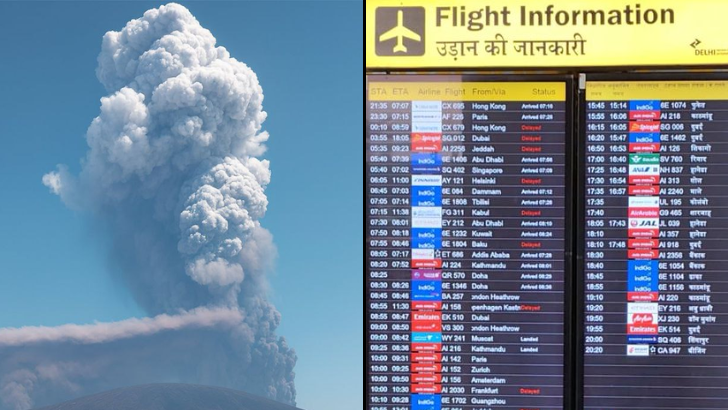Ethiopia volcano eruption: Delhi airport cancels 7 intl flights, delays others
An official said 7 international flights were cancelled and 12 international flights were delayed at the Delhi airport.
Salar Web
-
The ash initially entered Gujarat on Monday before spreading across North India (Screengrab/ANI)
New Delhi, 25 Nov
At least 7 international flights were cancelled and more
than 10 overseas flights delayed at the Delhi airport on Tuesday as ash plumes
from the volcanic eruption in Ethiopia impacted airlines' operations.
Air India has cancelled 13 flights since Monday.
Ash clouds from the recent eruption of the Hayli Gubbi
volcano in Ethiopia are impacting flight operations, and there are reports
suggesting that clouds are drifting towards the western parts of India.
An official said 7 international flights, including arrivals
and departures, were cancelled and 12 international flights were delayed at the
Delhi airport due to the impact of the volcanic ash plumes.
The Indira Gandhi International Airport in the national
capital is the country's largest airport, handling over 1,500 flight movements
daily.
There was no immediate update about the situation on Tuesday
from other Indian carriers.
On Monday, the Directorate General of Civil Aviation (DGCA)
asked airlines to strictly avoid published volcanic ash affected areas and
flight levels, adjust flight planning, routing, and fuel considerations based
on the latest advisories.
The plume, which moved across northwest India on Monday and
briefly disrupted flights, has since begun shifting towards China.
The ash mass had initially entered Gujarat on Monday before
spreading overnight across regions including Rajasthan, Maharashtra, Delhi-NCR,
Haryana and Punjab.
The eruption originated from Hayli Gubbi, a shield volcano
in Ethiopia's Afar region, which produced its first major activity in nearly
10,000 years and sent ash rising as high as 14 km.
The Toulouse Volcanic Ash Advisory Centre (VAAC) reported
that the explosive phase began around 8:30 am GMT, generating "a large ash
plume moving toward northern India" even after the eruption eased.
Ash columns from the Afar region, approximately 800 km
northeast of Addis Ababa near the Eritrean border, were carried across the Red
Sea to Yemen and Oman by strong upper-level winds, eventually drifting over the
Arabian Sea into western and northern India.
The IMD noted that the plume travelled along high-altitude
wind currents that transported it "from Ethiopia across the Red Sea to
Yemen and Oman and further over the Arabian Sea towards western and northern
India," with satellite tools, VAAC bulletins and dispersion modelling
aiding its monitoring.
A layer of haze settled over Delhi as the plume passed,
pushing air quality into the very poor band and raising concerns among
residents and authorities.
IMD's Met Watch Offices in Mumbai, New Delhi and Kolkata
issued ICAO-standard SIGMET warnings, advising airports to avoid specific
airspace segments and flight levels flagged by VAAC.
As the ash cloud advanced, flight operations across multiple
regions experienced strain, prompting the Directorate General of Civil Aviation
(DGCA) to circulate a detailed advisory on Monday.
Airlines such as IndiGo, Akasa Air and KLM revised their
schedules while officials continued keeping track of the plume's progression.
Leave a Reply
Your email address will not be published. Required fields are marked *












.png)




.png)
.png)

